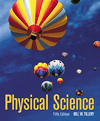You use light and your eyes more than any other sense to learn about your
surroundings. All of your other senses--touch, taste, sound, and smell--involve
matter, but the most information is provided by light. Yet, light seems more
mysterious than matter. You can study matter directly, measuring its dimensions,
taking it apart, and putting it together to learn about it. Light, on the other
hand, can only be studied indirectly in terms of how it behaves (Figure 8.1).
Once you understand its behavior, you know everything there is to know about
light. Anything else is thinking about what the behavior means. The behavior of light has stimulated thinking, scientific investigations,
and debate for hundreds of years. The investigations and debate have occurred
because light cannot be directly observed, which makes the exact nature of light
very difficult to pin down. For example, you know that light moves energy from
one place to another place. You can feel energy from the sun as sunlight warms
you, and you know that light has carried this energy across millions of miles
of empty space. The ability of light to move energy like this could be explained
(1) as energy transported by waves, just as sound waves carry energy from
a source, or (2) as the kinetic energy of a stream of moving particles,
which give up their energy when they strike a surface. The movement of energy
from place to place could be explained equally well by a wave model of light
or by a particle model of light. When two possibilities exist like this in science,
experiments are designed and measurements are made to support one model and
reject the other. Light, however, presents a baffling dilemma. Some experiments
provide evidence that light consists of waves and not a stream of moving particles.
Yet other experiments provide evidence of just the opposite, that light is a
stream of particles and not a wave. Evidence for accepting a wave or particle
model seems to depend on which experiments are considered. The purpose of using a model is to make new things understandable in terms
of what is already known. When these new things concern light, three models
are useful in visualizing separate behaviors. Thus, the electromagnetic wave
model will be used to describe how light is created at a source. Another model,
a model of light as a ray, a small beam of light, will be used to discuss some
common properties of light such as reflection and the refraction, or bending,
of light. Finally, properties of light that provide evidence for a particle
model will be discussed before ending with a discussion of the present understanding
of light. |



 2002 McGraw-Hill Higher Education
2002 McGraw-Hill Higher Education

 2002 McGraw-Hill Higher Education
2002 McGraw-Hill Higher Education